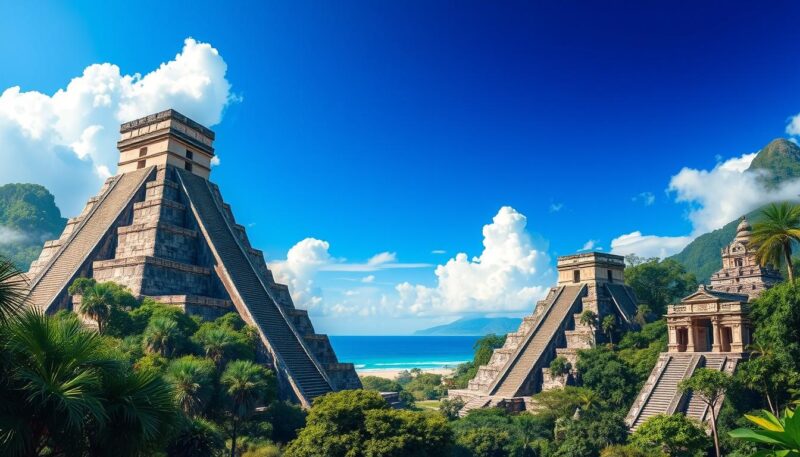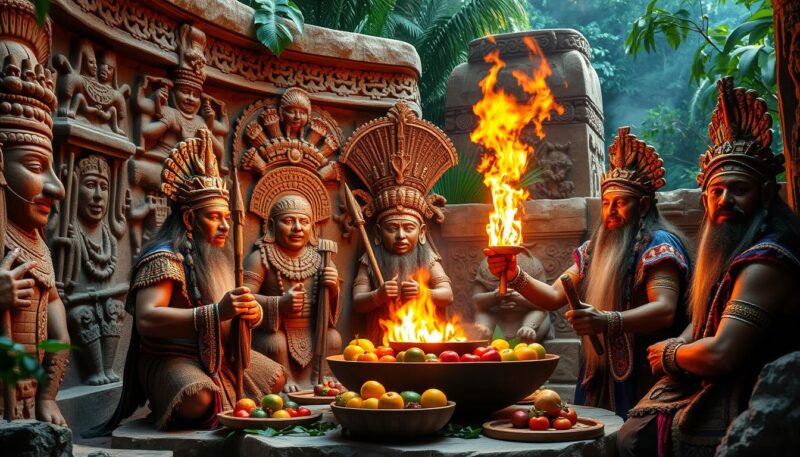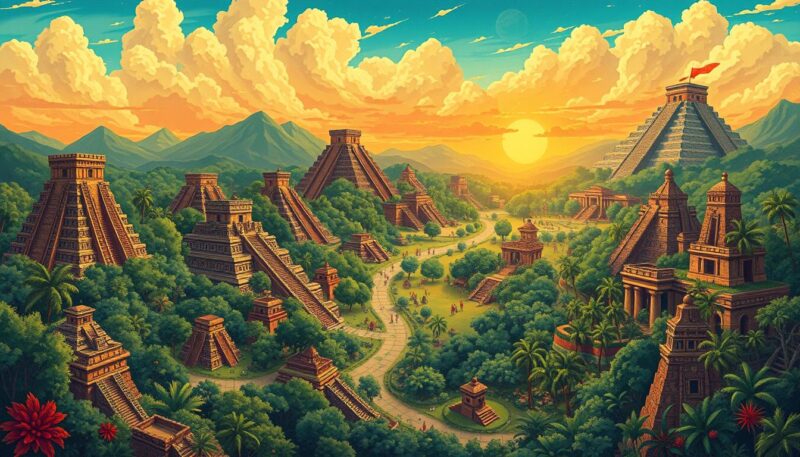The Mayan Empire, one of Mesoamerica’s most fascinating civilizations, boasts a rich history that spans thousands of years. The timeline of the Maya reveals the intricate tapestry of their rise, glory, and eventual decline. From as early as 7000 B.C. to the Spanish conquest in the 16th century, the Mayans thrived in regions now part of Mexico, Guatemala, Belize, and Honduras. Central to understanding the Mayan civilization history is recognizing the stages of development, from hunter-gatherer communities to sophisticated city-states brimming with culture and innovation.
One of the significant achievements of the ancient Maya was their remarkable advancements in numerous fields—ranging from astronomy to the intricate artistry of their monuments. The Mayan civilization reached its highest point during the Classic Period, which lasted from 250 to 900 CE, showcasing the rise of monumental architecture and an unparalleled societal structure. This era is characterized by a flourishing cultural life and a complex relationship with neighboring civilizations. However, even amid their grandeur, the Maya faced challenges that would ultimately contribute to their decline, a process featuring internal strife, resource management issues, and environmental stressors.
This article delves into the detailed timeline, highlighting the key milestones and transformations within the Mayan Empire. As we explore the origins of the civilization and their rise to power, we will also consider the cultural achievements that stand as a testament to their enduring legacy. Join us as we navigate the captivating history of the Mayan Empire, unveiling not only their remarkable accomplishments but also the factors that led to their eventual transformation.
Origins and Early Development of the Mayan Civilization
The early stages of the Mayan civilization are marked by significant cultural and societal transformations from the Preclassic period, spanning from 2000 B.C. to 250 A.D. This era laid the groundwork for what would become one of the most advanced cultures in Mesoamerican history. During this time, the transition from hunter-gatherers to structured agricultural settlements initiated profound changes in the lives of the ancient Maya.
Preclassic Period: Foundations of Mayan Society
The foundations of Mayan society took shape during the Preclassic Maya era. This period saw the emergence of farming villages characterized by the cultivation of staple crops such as maize, beans, and squash, which became essential to Maya agriculture. Archaeological findings indicate the establishment of larger settlements like Copán and Chalchuapa around 1000 B.C., exemplifying early complex urban planning. The pyramid structures began appearing, which would later become iconic ancient Maya achievements. By the time the Maya adopted the use of monumental architecture, their calendars had already been recorded in stone.
Transition from Hunter-Gatherers to Agricultural Settlements
The transition of the Maya from hunter-gatherer societies to stable agricultural settlements played a crucial role in their development. This shift allowed for increased food production, bolstered by innovations such as nixtamalization, increasing nutritional value from maize. The resulting agricultural settlements supported population growth and led to the formation of more permanent communities. These changes laid the groundwork for advanced trade networks and social complexity, creating a foundation for the later city-states that would define the Maya civilization.
Influence of Neighboring Civilizations: The Olmecs
The Olmec civilization significantly impacted the cultural development of the Maya. Between 1500 B.C. and 400 B.C., the influence of Olmecs shaped various elements of Mayan society, including religious rituals and artistic practices. The monumental sculptures and urban planning established by the Olmecs inspired the emerging cultures of the Mayan people. Elements such as pyramid-building and governance influenced ancient Maya achievements, enriching Mesoamerican history and illustrating how cultural exchanges shaped the foundations of civilization.
| Year | Event |
|---|---|
| 2000 B.C. | Emergence of farming villages across the Maya region |
| 1500 B.C. | Development of the Olmec civilization |
| 1000 B.C. | Establishment of larger settlements at Copán and Chalchuapa |
| 600 B.C. | Construction of large buildings in El Mirador |
| 400 B.C. | First Mayan calendars recorded in stone |
| 300 B.C. | Adoption of monarchy, governance led by kings |
| 100 B.C. | Foundation of the city-state of Teotihuacan |
Mayan Empire Timeline: The Rise to Power
The rise of the Maya around 250 CE marked a transformative period characterized by the establishment of city-states and the development of intricate political structures. These city-states emerged as independent entities, each governed by local rulers who held power over their respective regions, engaging in both commerce and conflict. The competitive nature between these cities significantly influenced their political frameworks and social hierarchies.
Establishment of City-States and Political Structures
The formation of city-states during the Classic Period Maya created a dynamic sociopolitical landscape. Major city-states such as Tikal, Copán, and Calakmul established finely tuned political systems, allowing for organized governance and administrative control. These city-states often engaged in alliances, military struggles, and trade, showcasing their power and cultural influence across Mesoamerica.
Key Achievements During the Classic Period (250-900 CE)
The Classic Period is recognized for the remarkable achievements of the Maya, spanning multiple fields such as art, mathematics, and astronomy. The Maya developed a complex hieroglyphic writing system, creating records that have allowed modern Maya archaeology to piece together their storied past. The building of monumental structures during this era highlighted their architectural innovations, with intricately designed temples and pyramids standing testament to their advanced understanding of engineering and design.
Cultural and Architectural Innovations
This rich era boasted significant cultural achievements, blending spiritual beliefs with stunning Mayan art and architecture. Public spaces were adorned with elaborate carvings and sculptures, displaying both the artistic prowess of the civilization and their dedication to religious practices. The alignment of structures with celestial events indicates a sophisticated understanding of astronomy, further cementing the Mayans’ ingenuity in architectural innovations.
Major Maya City-States: Tikal, Tulum, and Copán
Among the Major Maya city-states, Tikal emerged as a significant political and economic hub, marked by its iconic pyramids and expansive plazas. Copán, known for its intricate sculptures and detailed hieroglyphs, served as a crucial center for cultural exchange. Meanwhile, Tulum, located on the Caribbean coast, functioned as an active port city, facilitating trade and interaction with other regions. These city-states collectively illustrated the diversity and dynamism of the classic Maya civilization, thriving through interconnected networks of trade and cultural exchange.

The Golden Age of the Mayan Civilization
During the Golden Age of the Mayan civilization, which spanned approximately from 250 AD to 900 AD, a remarkable societal framework appeared alongside profound cultural and intellectual achievements. At this time, the Maya developed a complex social structure and integrated religious beliefs into the everyday lives of the people. Innovations in art, advancements in astronomy, and the evolution of the Mayan writing system contributed to a flourishing civilization. The spiritual life of the Maya highlighted the importance of sports and rituals, showcasing their deep connections between cultural practices and religious observance.
Social Structure and Religious Beliefs
The Maya social structure featured a rigid hierarchy, comprising nobility, priests, artisans, and farmers. The noble class wielded considerable power and was often believed to have direct ties to the gods, reinforcing the divine kingship concept. The religious beliefs of the Maya emphasized a pantheon of deities linked to natural and agricultural phenomena. These beliefs were integral to the spiritual life of the Maya, where rituals such as bloodletting and human sacrifices were performed to ensure fertility and appease gods.
Advancements in Art, Astronomy, and Writing
Maya art reached extraordinary heights during this period, with intricate murals, pottery, and stone carvings showcasing their cultural depth. Artists often depicted divine figures and historical events, thereby preserving the civilization’s rich heritage. The Maya’s advancements in astronomy allowed for the creation of sophisticated calendars that incorporated the mathematical concept of zero, enabling precise predictions of celestial events. The Mayan writing system emerged as the most developed in pre-Columbian Americas, facilitating the accurate recording of history and knowledge.
Sports and Rituals: The Spiritual Life of the Maya
The spiritual life of the Maya encompassed various sporting activities, with the Mesoamerican ballgame holding significant cultural importance. This game wasn’t merely for entertainment; it featured strong ties to religious and social realms, with outcomes often linked to rituals of the Maya. Participation in these athletic events included elaborate ceremonies that highlighted the intersection of sport and spirituality. As such, they played a crucial role in fortifying community ties and honoring the gods.

| Aspect | Details |
|---|---|
| Maya Social Structure | Nobility, priests, artisans, farmers; a hierarchy where nobles held power. |
| Religious Beliefs | Pantheon of gods linked to nature; rituals for agricultural fertility. |
| Maya Art | Intricate murals, ceramics, carvings; preserved history and culture. |
| Advancements in Astronomy | Created calendars; utilized the concept of zero for celestial predictions. |
| Mayan Writing System | Most developed writing in pre-Columbian Americas; key for record-keeping. |
| Maya Sports | Mesoamerican ballgame; important for cultural and religious practices. |
| Spiritual Life | Engagement in rituals and ceremonies; ties to athletic events. |
Conclusion
The timeline of the Mayan Empire encapsulates a remarkable narrative that interweaves its rise, golden age, and eventual decline. The Postclassic Period, particularly between the 9th and 10th centuries, saw increasing challenges that led to its dispersed communities and the emergence of various Mayan collapse theories. Factors such as environmental degradation, social conflicts, and resource scarcity severely undermined the once-flourishing civilization. The majestic city of El Mirador, among the lost Mayan cities, stands as a testament to this vibrant culture, even as the echoes of its achievements resonate through time.
The Spanish conquest of the Maya, which extended from 1524 to 1697, further complicated the legacy of this great civilization. It marked a significant turning point, as the Itza were the last group to be subdued, effectively ending an era that had already been challenged. This colonial period ushered in a profound transformation, impacting not only the political landscape but also the cultural and social fabric of the Mayan peoples.
Today, the remnants of the Maya serve not only as archaeological wonders but also symbolize resilience and identity for many modern descendants. The exploration of lost Mayan cities inspires intrigue among historians and archaeologists alike, fostering ongoing discussions about the intricate history and the enduring contributions of this ancient civilization.

